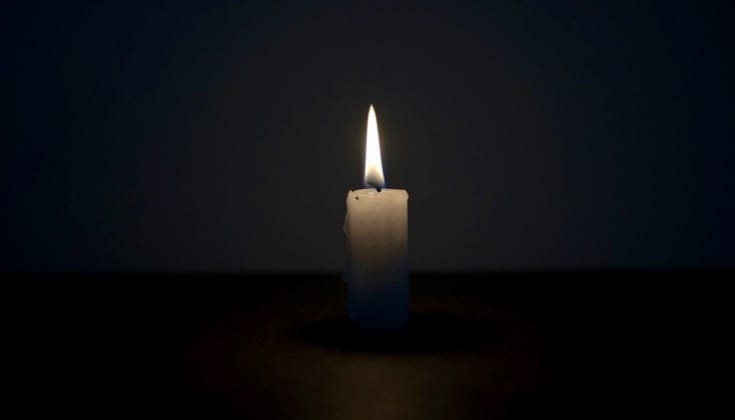When tragedy strikes, we can feel like the ground has dropped out from under our feet. The Buddhist view, though, is that these experiences offer an opportunity to directly experience wisdom and compassion — exactly what is needed in times of crisis.
American-born Tibetan Buddhist nun Pema Chödrön and Zen teacher Bernie Glassman both offer us three-step practices for working with tragedy and difficulty in this way. Though these practices come from two very different traditions, the similarities between them are striking.
“Whatever ideas people have of what’s going to happen when they go out, they’re wrong, and what they learn will be from the unknown,” Bernie once told Lion’s Roar. “I think charnel ground practices are very similar,” he added, giving a nod to Tibetan Buddhist practice.
As Pema explains, a “charnel ground,” here, is a traditional Tibetan idea of a graveyard, where — because the earth is frozen — bodies are left out in the open to be eaten by vultures. Tibetan Buddhists use the image of the charnel ground to as a metaphor for the harsh reality of human life: “It smells, it bleeds, it is full of unpredictability,” says Pema, “but at the same time, it is self-radiant wisdom.” The charnel ground of our ordinary life, says Pema, is the working basis for attaining enlightenment.
In parallel instructions, Pema and Bernie explain how to meditate in the unknown, draw the focus of one’s meditation to suffering, and then bring that meditation into the real world.
“Times are difficult globally,” explains Pema. “Awakening is no longer a luxury or an ideal. It’s becoming critical.” Bernie sees practice in a similar light, saying we can use meditation to “get involved in the healing of the earth, in the making whole of the human race.”
Pema’s practices, as she teaches them in “Three Methods for Dealing with Chaos,” are framed as three separate methods, yet they flow smoothly from one to the next. Bernie’s teachings, called “The Three Tenets of the Zen Peacemakers” come from his conversation with Lion’s Roar and a teaching on the three tenets.
See how they compare, and if one — or both — are helpful to you in navigating challenges.
Step One: Let Go of Concepts
Pema Chodron: “No More Struggle”
The first method, no more struggle, is epitomized by shamatha-vipashyana (insight-awareness) meditation instruction. When we sit down to meditate, whatever arises in our minds we look at directly, call it “thinking,” and go back to the simplicity and immediacy of the breath. Again and again, we return to pristine awareness free from concepts. Meditation practice is how we stop fighting with ourselves, how we stop struggling with circumstances, emotions or moods. This basic instruction is a tool that we can use to train in our practice and in our lives. Whatever arises, we can look at it with a nonjudgmental attitude.
This instruction applies to working with unpleasantness in its myriad guises. Whatever or whoever arises, train again and again in looking at it and seeing it for what it is without calling it names, without hurling rocks, without averting your eyes. Let all those stories go. The innermost essence of mind is without bias. Things arise and things dissolve forever and ever. That’s just the way it is.
The Tibetan yogini Machig Labdron was one who fearlessly trained with this view. She said that in her tradition they did not exorcise demons. They treated them with compassion. The advice she was given by her teacher and passed on to her students was, “Approach what you find repulsive, help the ones you think you cannot help, and go to places that scare you.” This begins when we sit down to meditate and practice not struggling with our own mind.
Bernie Glassman: “Not Knowing”
The first is penetrating into the unknown. Forget all the methods that you know about. Not that you throw them out; they’re there somewhere. But first drop all the ideas that you know how to take care of the situation you’re about to enter. Enter the situation with the mindset that you have no idea how to take care of it.
I’ve instituted practices of taking people into situations like Auschwitz or living on the streets, where it is so overwhelming that you lose control of your attachment to the idea of ego. You’re put into a situation where you just don’t know anymore what’s happening; it’s an overload of the system.
We’re asking that you forget all the methods that you know about… First drop all the ideas that you know how to take care of the situation you’re about to enter. Enter the situation with the mindset that you have no idea how to take care of it.
For me, part of the state of not knowing is entering into the worlds I am afraid of, entering into worlds about which I have no idea. I’m drawn to those aspects of myself that I do not understand, that I fear, that are a mystery. I’m drawn to enter that realm.
Step Two: Bring Awareness In
Pema Chödrön: “Using Poison as Medicine”
The second method is to use poison as medicine, to use difficult situations to awaken our genuine caring for other people who, just like us, often find themselves in pain. We can use every day of our lives to take a different attitude toward suffering. Instead of pushing it away, we can breathe it in with the wish that everyone could stop hurting, with the wish that people everywhere could experience contentment in their hearts.
When anything difficult arises—any kind of conflict, any notion of unworthiness, anything that feels distasteful, embarrassing, or painful—instead of trying to get rid of it, we breathe it in. We do this with the wish that all of us could be free of suffering. Then we breathe out, sending out a sense of big space, a sense of ventilation or freshness. We do this with the wish that all of us could relax and experience the innermost essence of our mind.
Bernie Glassman: “Bearing Witness to the Joy and Suffering of the World”
The second step is bearing witness. Sit with that situation; bear witness to it.
Step Three: Respect What Arises
Pema Chödrön: “Seeing Whatever Arises as Enlightened Wisdom”
The third method for working with chaos is to regard whatever arises as the manifestation of awakened energy. We can regard ourselves as already awake; we can regard our world as already sacred.
We can acknowledge that suffering exists, that darkness exists. The chaos in here and the chaos out there is basic energy, the play of wisdom. Whether we regard our situation as heaven or as hell depends on our perception.
Bernie Glassman: “Healing Ourselves and the World”
The third is healing oneself and others, out of the ingredients that come up from bearing witness. By feeling what’s happening, letting the ingredients of the situation arise, you can take those ingredients to create a healing meal.
Read more on each of these teachings in “Three Methods for Working With Chaos,” by Pema Chödrön and “The Three Tenets of the Zen Peacemaker Order” by Bernie Glassman.

